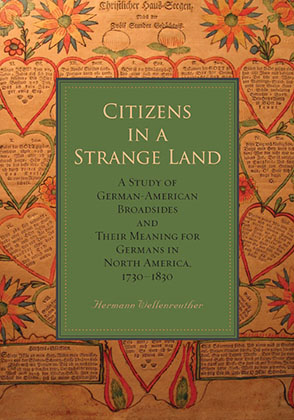Hermann Wellenreuther. Citizens in a Strange Land: A Study of German-American Broadsides and Their Meaning for Germans in North America, 1730–1830. Max Kade German-American Research Institute Series. University Park: Pennsylvania State University Press, 2013. xv, 384p., ill. ISBN 9780271059372. US$ 98.95.
A research team from Gottingen, headed by the author, provides us with a study of some 215 early American broadsides produced by Germans in order to shed light on the society of German farmers who settled in Pennsylvania between 1730 and 1830. Contemporary English broadsides are ignored, on the assumption that German society was largely self-contained. “Broadside” is carefully defined as “a sheet that is printed on a single sheet on either one or both sides irrespective of its contents.” There are four chapters, dealing respectively with printers, secular life, religion, and politics. However, despite a truly exceptional pamphlet by Saur, politics seems of marginal interest. The secular chapter already shows the dominance of religion, so this review can be focused upon the first two chapters.
There were many printers of broadsides. From extant ledgers, we know that a wide range of topics were asked for, from natural history and storybooks to moral treatises. The broadsides were distributed by booksellers, peddlers, and by mail order. Since the cost was borne by the person who ordered the broadsides, the customer had to compare the cost of a broadside with that of an advertisement. Readers’ interests, as well as some of their steadiest customers, were religious, mainly Protestant, and focused upon pietism. Several used murders to illustrate religious commandments. An insightful riddle of one asks, “Where do the dead bury the living?” The answer lies in recognizing that, to the settlers, Fire was considered living matter; thus the answer “Where the ashes cover the fire.”
The broadsides suggest that German wives had a stronger role than English wives; a poem dealing with Adam and Eve does not lay the curse on Eve alone or Adam and Eve together, but only on Adam. The care with which some wills stipulated provision for aged parents suggests a society in which care of one’s parents was no longer taken for granted. A third of the broadsides deal with everyday problems, such as medical concerns, or advertise goods and services, or relate to tools used to ease and improve production. Such issues were better dealt with in books, but they were beyond the budget of the average German settler. The medical broadsides show kidney stones and gallstones, pregnancy, vomiting and gout as the main concerns. Most German readers of these works were farmers, and discussion of such everyday problems as conversion from decimals into the English system, horses, infrastructure, and markets is common. A striking feature of notices of farms placed for sale is that, in addition to features like accessibility and infrastructure, the owners of the adjoining lots were named. Most wool and linen cloth was both produced and consumed at home and the utensils advertised for sale suggest farmers who were neither excessively rich nor poor.
The number of broadsides that focus on prayer, blessing, and piety tell us that daily life was embedded within Christian beliefs. Consider one such prayer: “Even when young, think of your final last day, accept the wisdom of what you are being taught, bind yourselves to the pure wisdom, and look for it as a youngster as well as a man.” Prominently-displayed house blessings informed visitors that the house valued piety and a Christian lifestyle. Himmelsbriefe or “heavenly letters” seem peculiar to the Germans and reflect the belief that God directly inspired particular persons, who then acted as scribes and wrote them. The Himmelsbriefe were used to remind one of common lapses, such as failing to observe the Sabbath, or to protect against dangers, such as fire. Over fifty broadsides of confirmation songs remind us of the importance of a religious entrance into adulthood. It was important to know the Bible for almost all aspects of life.
The book’s format is pleasing. It has some lovely color illustrations, and there were very few typos. I now turn to some critical observations on an otherwise enjoyable volume. On p. 113 we are told that “There was one genre that one might not expect to be of interest to these sober, serious-minded Germans – or perhaps they especially needed the ‘how to’ books of the eighteenth and early nineteenth centuries.” Were these manuals about sex? One misses seeing translations throughout the book, but nowhere more so than on this page. Four broadsides focus on slavery, but as only two condemn it. The author concludes that antislavery sentiments were limited. As Germans were generally known to oppose slavery, perhaps the inference is mistaken. Finally, The “Pennsylvania Dutch” are mentioned in three places, but the belief prevalent in the United States that “Dutch” is just a corruption of “Deutsch” is not mentioned.
Salim Rashid
Universiti Utara Malaysia


